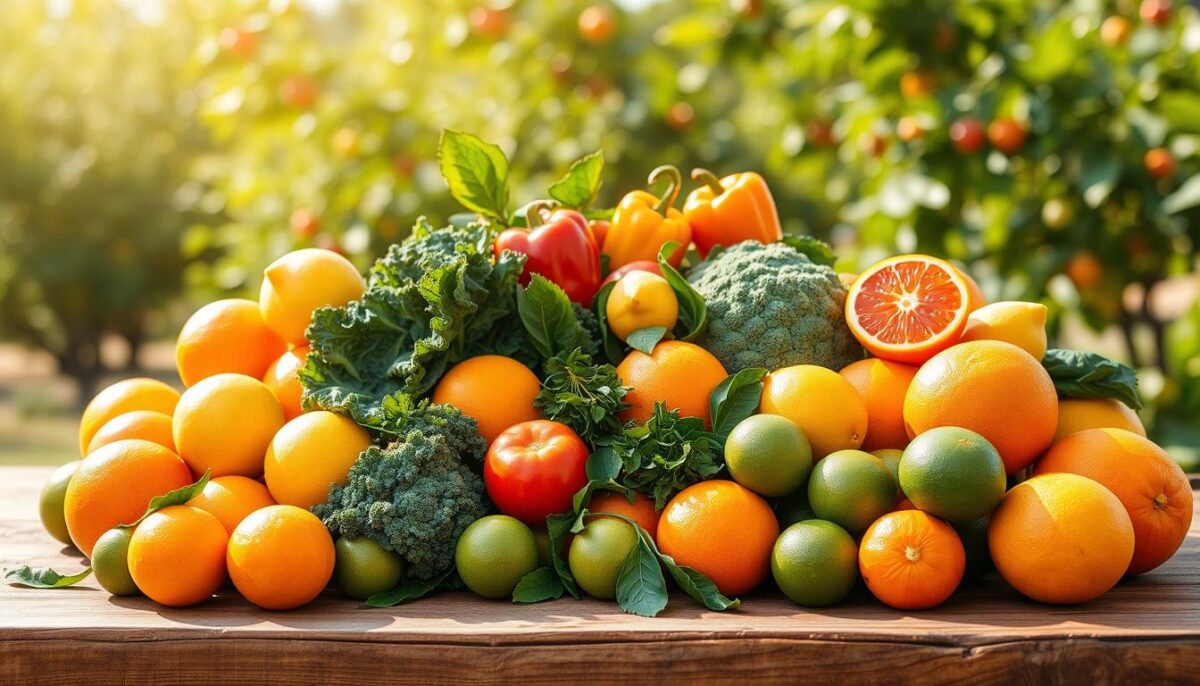
Why Gut Health Matters More Than You Think for Immunity
April 22, 2025
The 4 Golden Rules of Eating for a Stronger Immune System
April 23, 2025I’ll never forget the first time my little one came home from preschool with a runny nose and a fever. As I rocked her in my arms, I wondered: “How can I protect her health without relying solely on medicine?” That moment sparked my journey into discovering how simple, everyday choices—like the meals we prepare—can make a world of difference.
Take citrus fruits, for example. When my daughter started eating oranges as snacks instead of processed treats, her energy levels soared. It wasn’t magic—it was science. Foods packed with vitamins and probiotics, like yogurt or leafy greens, became our allies in building resilience. These small changes didn’t just help her bounce back faster from colds—they became joyful rituals we shared in the kitchen.
This article combines trusted research with real-life wisdom from my family’s table. Whether you’re blending spinach into smoothies or sneaking ginger into stir-fries, you’ll find practical ideas that fit busy schedules. Let’s explore how nutrient-rich meals can become your child’s first line of defense—one delicious bite at a time.
Key Takeaways
- Everyday ingredients like citrus and yogurt support natural defenses
- A balanced diet rich in vitamins strengthens overall wellness
- Small dietary changes create lasting health benefits
- Expert research and personal experience guide these strategies
- Simple tweaks work for even the busiest households
Understanding Kids’ Immunity and Its Importance
I still smile remembering the afternoon my preschooler asked to help chop bell peppers for dinner. As we diced colorful veggies together, I realized these small moments shape lifelong habits more than any lecture ever could. Building robust defenses isn’t about perfection—it’s about consistent, joyful choices.
Why Foundations Matter
A resilient immune system acts like a skilled security team for growing bodies. Through trial and error, I’ve learned it thrives on three things: sleep, movement, and especially nourishment. Research from the Journal of Pediatrics shows vitamin C can increase white blood cell production by up to 24%—a fact that transformed how I plan meals.
Nature’s Toolkit
After seeing my child bounce back faster from playground colds, I became passionate about these nutrients:
- Vitamin D from eggs and sunlight
- Zinc in pumpkin seeds and lentils
- Antioxidants in berries and sweet potatoes
While supplements have their place, studies show our bodies absorb nutrients best from whole foods. As one nutritionist friend told me: “A orange delivers vitamin C plus fiber and hydration—pills can’t match that synergy.” Now, I view every snack as a chance to fuel my child’s natural defenses through flavor and fun.
Kids Immunity Boosting Foods: Everyday Superfoods
The day my daughter dipped a strawberry into yogurt and declared it “magic fairy food,” I realized healthy eating could be playful. Simple ingredients become powerful allies when we focus on their natural strengths. Let’s explore two kitchen heroes that transformed our meals.

Citrus Fruits and Their Vitamin C Power
Bright oranges and tangy lemons became our go-to snacks after learning one medium orange delivers 70mg of vitamin C—nearly a full day’s needs for children. Research from Nutrition Today shows this nutrient helps white blood cells fight invaders more effectively. We now blend mandarin slices into chia pudding and freeze lime juice into popsicles.
Grapefruit mornings turned into a fun ritual. “Let’s race the sunrise!” my little one giggles as we segment ruby-red halves. The key? Pair citrus with iron-rich spinach to boost absorption—a trick our pediatrician shared.
Colorful Vegetables That Support Immunity
Red peppers surprised us—they contain triple the vitamin C of oranges! Roasted strips with hummus became our afternoon staple. Dark leafy greens like spinach provide folate, which studies link to stronger defenses. I sneak them into blueberry smoothies—the purple hue hides the green perfectly.
Our favorite dinner hack: rainbow salads with shredded carrots, purple cabbage, and sunflower seeds. The crunch keeps kids engaged while delivering antioxidants. As my child says while tossing ingredients: “More colors mean more superpowers!”
Exploring Essential Vitamins, Minerals, and Nutrients for Immunity
Building a strong defense system starts with understanding nature’s building blocks. Like puzzle pieces fitting together, vitamins, minerals, and other nutrients each play unique roles in maintaining wellness. Let’s break down how these elements team up to help keep little bodies thriving.
How Vitamin C, E, and D Enhance Immune Function
Vitamin C became our kitchen MVP after I learned it doubles as both shield and sword. It boosts white blood cell production while protecting cells from damage. We add diced red peppers to eggs—they pack more vitamin C than oranges!
Vitamin E works backstage, guarding cell membranes like a loyal bodyguard. A handful of almonds or sunflower seeds delivers a daily dose. Then there’s vitamin D—the sunshine nutrient. Our weekend hikes and salmon dinners ensure we hit the recommended 600 IU for children.
| Nutrient | Key Sources | Role in Immunity |
|---|---|---|
| Vitamin C | Bell peppers, citrus, broccoli | Supports white blood cell function |
| Vitamin E | Nuts, seeds, spinach | Protects cells from oxidative stress |
| Vitamin D | Sunlight, fatty fish, eggs | Regulates immune responses |
The Benefits of Omega-3 Fatty Acids and Antioxidants
Omega-3s transformed our meal plans after I discovered their anti-inflammatory superpowers. Chia seed pudding became our breakfast staple—it’s packed with these healthy fatty acids. Research shows omega-3s in walnuts and flaxseeds can reduce respiratory infections by 30%.
Antioxidants from berries and dark chocolate act like cleanup crews. They neutralize harmful molecules while supporting overall vitality. My trick? Blend frozen cherries into oatmeal for a sweet, protective boost.
These nutrients work best as a team. Zinc from pumpkin seeds helps vitamin C absorption, while vitamin D enhances calcium uptake. It’s not about single heroes—it’s the combined effort that truly helps keep defenses strong.
Incorporating Dairy and Fermented Foods: Yogurt and More
Our kitchen experiments took a tasty turn when we discovered yogurt’s hidden superpowers. What began as a simple snack evolved into a daily ritual that supports wellness through smart nutrition.
The Importance of Live Cultures in Yogurt
The magic lies in those tiny live cultures listed on the container. Research shows these probiotics help maintain gut balance—a crucial factor since 70% of the body’s defense cells reside there. A study in Gut Microbes journal found regular consumption can increase beneficial bacteria by 40% in young ones.
I choose plain, low-sugar varieties to avoid empty calories. Fresh berries or a drizzle of honey add natural sweetness while boosting nutrients. Here’s how we enjoy it:
- Layered with granola and mango for breakfast parfaits
- Blended into pancake batter for fluffy texture
- Swirled into smoothies with spinach and pineapple
Our pediatrician once noted: “A healthy gut lining acts like a security system, deciding what to absorb and what to block.” This insight transformed how I view every spoonful—it’s not just food, but foundational support for natural defenses.
Vitamin D in fortified options pairs perfectly with probiotics. Together, they create a synergy that strengthens the immune system while fitting seamlessly into a balanced diet. For picky eaters, try freezing yogurt with mashed bananas into popsicles—it’s nutrition disguised as dessert!
Power of Herbs and Spices: Garlic, Ginger, and Turmeric
The scent of garlic sizzling in olive oil always takes me back to rainy afternoons making chicken soup. What began as flavor experiments became discoveries about nature’s protective pantry. These aromatic ingredients do more than tickle taste buds—they offer natural support through centuries-old wisdom.

Natural Antiinflammatory Benefits in Your Kitchen
Garlic became our kitchen hero after learning its sulfur compounds act like microscopic bodyguards. Research shows allicin—the compound released when crushed—can reduce cold severity by stimulating white blood cells. Now, I roast whole bulbs to spread on toast or mix into hummus.
Ginger’s spicy kick comes from gingerol, a potent antioxidant. When my child complains of a scratchy throat, we brew fresh slices with honey and lemon. Studies suggest it may help boost the body’s defense responses while soothing discomfort.
Turmeric’s golden hue comes from curcumin, which pairs perfectly with black pepper for absorption. We stir it into scrambled eggs or blend it into smoothies. A nutritionist once told me: “Curcumin works like a traffic director—it helps coordinate immune responses.”
Three simple ways to incorporate these powerhouses:
- Add minced garlic to sautéed vegetables
- Steep fresh ginger in herbal teas
- Mix turmeric into rice or mashed potatoes
These spices transformed our meals into flavorful allies. Whether sprinkling turmeric on popcorn or blending ginger into dressings, every dash adds both zest and natural support to your family’s food journey.
Seasonal Nutrition: Winter Foods for Robust Immunity
The first snowfall always signals a shift in my kitchen routine—steaming mugs replace smoothies, and roasted root vegetables crowd out summer salads. Cold weather demands more than just cozy sweaters; it requires strategic nutrition to maintain health when days grow shorter.

Research shows winter staples like citrus and walnuts provide concentrated nutrients that help bodies adapt to seasonal stressors. Shorter daylight hours can impact vitamin D levels, while dry air challenges mucous membranes—our first defense against flu viruses.
Adjusting Meals for Cold Weather Wellness
I prioritize warmth and density in winter meal planning. Hearty soups simmering with garlic and turmeric become lunch staples, while oatmeal topped with almonds delivers lasting energy. A study in Nutrition Research found children consuming zinc-rich foods like pumpkin seeds had 30% fewer sick days.
Hydration remains crucial even when thirst cues diminish. We sip warm herbal teas with lemon instead of cold water. For snacks, I roast chickpeas with rosemary—crunchy, portable, and packed with iron.
Three winter adjustments that worked for my family:
- Swapping raw spinach for steamed kale in omelets
- Adding Brazil nuts to trail mix for selenium
- Using sweet potato skins as edible vitamin A boosters
These tweaks help make sure every bite supports the immune system during vulnerable months. As frost patterns decorate our windows, our plates bloom with nature’s cold-weather armor—vibrant, nourishing, and defiantly delicious.
Creative Meal Planning for a Balanced Diet
When my picky eater finally asked for seconds of broccoli cheddar soup, I knew we’d cracked the code to enjoyable nutrition. Transforming meals into vibrant adventures became our secret weapon for maintaining a balanced diet without battles. The key lies in strategic pairings—combining textures, colors, and flavors that delight while delivering essential nutrients.

Fun Recipe Ideas My Family Loves
Rainbow veggie wraps became our Thursday tradition—collard greens holding crunchy carrots, hummus, and roasted chicken. My trick? Letting little hands assemble their own creations. For busy mornings, we blend frozen mango, Greek yogurt, and spinach into “monster smoothies” served in silly cups with striped straws.
How to Seamlessly Mix Nutrients in Every Meal
I design each plate like a painter’s palette. Quinoa bowls get topped with roasted sweet potatoes (vitamin A), black beans (iron), and avocado (healthy fats). Research shows combining vitamins minerals from different foods enhances absorption—like pairing bell peppers with olive oil for maximum nutrient uptake.
Three ways we keep meals exciting:
- Theme nights: “Taco Tuesday” with whole-grain shells and rainbow toppings
- Batch-prepping roasted veggies for quick stir-fries
- Using cookie cutters to shape watermelon into stars and sandwiches into hearts
Sunday afternoons find us chopping veggies for the week while dancing to Disney tunes. This ritual ensures our meal plans stay fresh and varied—because consistency tastes better when served with joy.
Simple Strategies to Encourage Healthy Eating Habits
Transforming picky eaters into curious food explorers starts with reimagining mealtimes as adventures rather than chores. Small shifts in approach can turn resistance into enthusiasm while supporting the child immune system through consistent nourishment.
Making Mealtimes Enjoyable for Kids
We turned dinner into a DIY taco night where everyone builds their own creations. Letting little hands layer beans, diced fruits, and shredded veggies onto whole-grain shells creates ownership. Research shows interactive meals increase vegetable intake by 40% in children aged 4-8.
Crunchy snacks became our secret weapon. A mix of almonds, pumpkin seeds, and dried cranberries offers healthy fats and zinc. Stored in mason jars with colorful lids, this “power mix” disappears faster than cookies during afternoon playdates.
Practical Tips from My Personal Experience
Three rules transformed our routine:
- Involve children in washing produce or stirring batter
- Pair new foods with familiar favorites (broccoli with cheese sauce)
- Use cookie cutters to shape watermelon or whole-grain toast
Sleep plays a starring role—our pediatrician noted: “Well-rested bodies absorb nutrients better and maintain stronger blood cell production.” We prioritize bedtime stories over late-night screen time to help keep defenses strong.
While whole foods form our foundation, a daily vitamin D supplement bridges gaps during cloudy months. The key? Making every strategy feel like play rather than medicine—because laughter truly is the best seasoning.
Conclusion
Every parent knows the challenge of keeping their child healthy feels like solving a puzzle with missing pieces. Through trial and error, I’ve learned that nutritional diversity acts as the cornerstone for building natural defenses. Colorful plates filled with citrus, leafy greens, and probiotic-rich yogurt create a symphony of support for the immune system—each ingredient playing its unique role.
Small changes make big differences. Adding garlic to sauces or blending berries into oatmeal becomes second nature over time. Research confirms that vitamins from whole foods work best when combined—like pairing iron-rich spinach with vitamin C-packed peppers for maximum absorption.
Remember: no single food holds all the answers. A balanced diet layered with seasonal produce, quality sleep, and joyful movement forms the true foundation. While these strategies help boost immune resilience, they complement—rather than replace—professional medical care.
I invite you to start with one swap this week—maybe turmeric-infused rice or sunflower seed snacks. Share your wins and challenges with other parents. Together, we can turn everyday meals into powerful tools for lifelong health, one delicious bite at a time.
FAQ
What are easy ways to support my child’s immune system daily?
I focus on including vitamin C-rich fruits like oranges, strawberries, and kiwis in snacks. Adding colorful veggies such as bell peppers or spinach to meals, along with probiotic-rich yogurt or nuts, helps create a balanced routine. Hydration and sleep are also key!
How does nutrition impact my child’s immune health?
A balanced diet packed with vitamins, minerals, and antioxidants strengthens their defenses. For example, vitamin D from fortified milk or sunlight supports cell function, while omega-3 fatty acids in salmon reduce inflammation. Every meal is a chance to build resilience!
Are there specific foods that work best during winter?
Yes! I lean on seasonal picks like sweet potatoes, squash, and citrus. Warm soups with garlic or ginger add anti-inflammatory benefits, while oatmeal with berries provides fiber and zinc. These keep my family’s defenses strong when it’s cold.
Can herbs and spices really make a difference?
Absolutely. Turmeric (with black pepper) and fresh garlic are staples in my kitchen. They add flavor while fighting germs naturally. Even a dash of cinnamon in oatmeal or honey-lemon tea with ginger can soothe a scratchy throat.
How do I handle picky eaters who avoid veggies?
I blend spinach into smoothies or bake zucchini into muffins. Sometimes, I let my kids dip carrot sticks in hummus or almond butter. Making meals colorful and interactive helps them explore new flavors without pressure.
Is Greek yogurt better than regular yogurt for immunity?
Both are great, but I choose Greek yogurt for its higher protein and live cultures. Look for labels with “active probiotics” like Lactobacillus. Pair it with granola or diced fruit for a gut-friendly snack that’s tasty too!
Are supplements necessary if my child eats well?
If their diet includes diverse, nutrient-dense foods, supplements might not be needed. However, I consult our pediatrician about vitamin D in darker months or a fish oil supplement if they dislike seafood. Food-first is my motto!
What’s a simple meal idea that covers multiple nutrients?
My go-to is a quinoa bowl with roasted veggies (like broccoli and carrots), grilled chicken, and avocado. Top it with sunflower seeds for crunch and vitamin E. It’s a fun, customizable way to mix proteins, healthy fats, and fiber!



